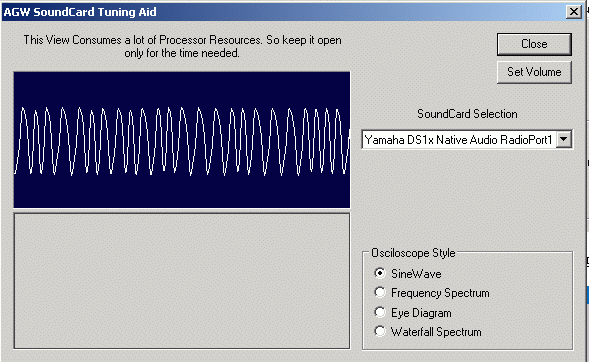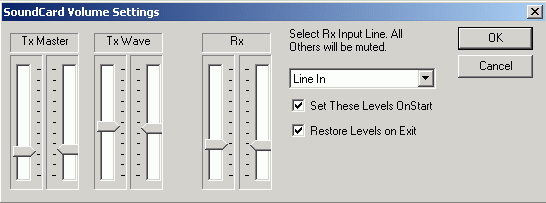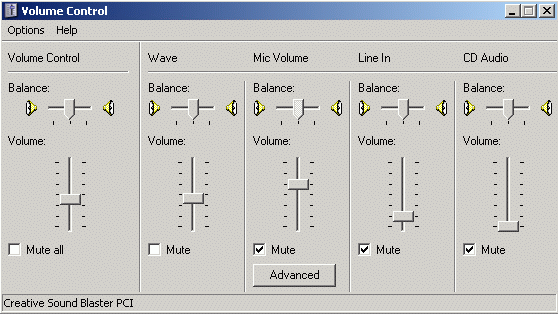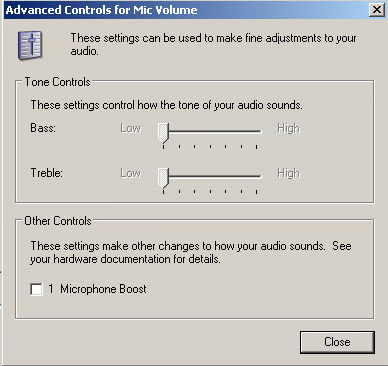 |
Introduction
AGWPE Overview
More about AGWPE
1. Interface
Getting Started
Kits and Pre-assembled
Receive Audio Cable
Transmit Audio Cable
PTT (TX Control) Cable
2 Radio Modification
2. AGWPE Set Up
Download and Install
Basic AGWPE Setup
2 Radio Setup
2 Card Setup
3. Sound Card Setup
Basic Settings
Additional Settings
Tuning Aid
4. Windows™ Setup
TCP/IP Settings
Update Windows
5. Problems?
Program Behavior
Receiving
Transmitting
Connections
6. Using AGWPE
AGWPE on a Network
Baud Rates & Modes
Remote Control
TCP/IP Over Radio
Tips and Tricks
Traffic Parameters
7. Compatible Programs
Configuration Help
and download URLs
|
|
Basic Sound Card Settings for
AGWPE
For AGWPE to work, you need to set four basic sound
card settings correctly:
 | The receive audio
source |
 | The receive audio
volume
level |
 | The transmit audio
source |
 | The transmit audio
volume
level |
You can adjust these sound card settings in two
ways:
Other information on this page includes:
There are some
advanced sound card settings that may also
affect you. These include "Speaker Type", "Hardware Acceleration", and
"Sample Rate". These are discussed on the
Additional Settings page of this web site.
1. Using AGWPE to Adjust Basic Sound Card Settings
To set the volume controls from within AGWPE, right click the AGWPE tower icon
 to
bring up the AGWPE menu and then click on
Sound
Card Tuning Aid. The Tuning Aid is a great way to adjust your
RX (receive) volume. Note that the Tuning Aid screen window will remain
on top of all other windows. You can drag it with the blue Title Bar if
it gets in the way, but it's handy to keep it displayed throughout the
volume adjusting process: to
bring up the AGWPE menu and then click on
Sound
Card Tuning Aid. The Tuning Aid is a great way to adjust your
RX (receive) volume. Note that the Tuning Aid screen window will remain
on top of all other windows. You can drag it with the blue Title Bar if
it gets in the way, but it's handy to keep it displayed throughout the
volume adjusting process:

Then in the AGWPE
Sound
Card Tuning Aid window, click
on the Set Volume button to get to this
window:

See the sections a. and b. below for more
information about these controls:
Bug
Report: There are still some problems with this AGWPE
feature as of 2003.308:
 | By default, this window assumes
the LINE IN is the RX Input Line.
If you are using LINE IN, then you will have no problems
and can use the volume sliders to adjust your RX audio
level.
The bug is that the window will
not let you change the RX
Input Line (audio source) as the pull down menu
suggests. For
example, if the sound card is now set to use the "LINE
IN" jack as the audio source, then selecting "MIC"
as the RX Input Line in
this window will have no affect. The sound card (and
AGWPE) will continue to use "LINE IN". You will be able
to control the volume sliders for the source you select,
e.g. MIC, but your input source will not change to MIC.
|
 | If you have two sound cards in your system, AGWPE only
controls the volume settings on the first sound card. If you are
using a second sound card for AGWPE, then this window
will have no affect on the settings for that second card. |
If either of these problems affect you, then you need to
use the Windows' Volume Control Program
(see #2 below)
to adjust the input source and/or the sound card being used. See #2 below. |
 | Receive Audio Volume: The
left
Rx slider controls the receive
volume (recording volume) of the left channel or port 1 of the
sound card. The right column sliders control the right channel or
port 2. (If you are using only one radio port in AGWPE, it will be the
left slider).
I've had
good success with the sliders set 1/3 up from the bottom. Be
sure not to set them too low since it may stop all input (they don't
have to be to the very bottom for audio input to be stopped). Use the
sound card tuning aid's Sine Wave scope to see the results of your
settings. The sine waves should fill about half the scope as in the
Tuning Aid screen shot above. Use the volume slider to adjust the
wave size. If you get the output from the radio's speaker jack, you
can also adjust the radio volume. AGWPE is pretty tolerant of RX
volume levels, but conceivably it is possible for the volume to be too loud or
too soft.
If
you don't see any waves, then your audio source setting is probably
incorrect (see next paragraph) or, if you are using the radio's mike
or speakers for RX audio, your radio's squelch in on; turn it off so
you can hear the channel noise.
|
 | Receive Audio Source:
See Bug Report above.
The Rx Input Line (audio source) does not work as advertised
in version 2003.3008. You need to use
the Windows' Volume Control Program
(see #2 below) to adjust your settings.
[When the bug is corrected, you will be able to select the source of your
receive audio, either Line (meaning LINE
IN) or
Microphone, depending where your RX audio
cable is plugged. As
the screen says, other sources will be muted and that's good.]
(If you opt to use the Microphone
instead of the Line In for RX in, be sure that you
do
not use the Microphone Boost option of your sound card. See
Windows' Volume Control Programbelow for
instructions on how to configure boost.)
|
 | Set/Restore Options: If you use your sound card
for programs other than AGWPE, the Set These
Levels on Start and Restore Levels on
Exit will be helpful. They allow you to set the volume
especially for AGWPE and then return them to their previous settings
when you exit AGWPE.
|
 | Transmit Audio Volume: The
Tx Master sliders and two Tx Wave
volume sliders work together: Wave means
Program, in this case AGWPE and the packet tones it generates. The
Tx Master sliders are a master control that will further
adjust the Wave volume.
As with the RX sliders, the left column sliders (for both Master and Wave) control the left channel or port 1 of the
sound card. The right column sliders control the right channel or
port 2.
I've had
good success with the sliders set 1/3 up from
the bottom. Your setting will depend largely on how well the
attenuation circuit in your TX audio cable matches the optimal
microphone input level for your radio. See How Much TX
Volume? below for some further advice.
It is essential that none of these two sliders be at the absolute
bottom or near the bottom, as that may stop all output.
|
|
You can get a rough idea
of your TX volume by temporarily plugging your computer
speakers into the LINE IN jack. But that will not tell you
how what your TX audio sounds like on the air. It would be
better to listen to your transmitted audio with a second
radio.
But
the best way to check your transmit volume is with a
deviation meter. The correct deviation
is 3.75 kHz of deviation (+/- .25).
But since most of us don't have a deviation meter,
Jim K6CCC offered this alternate
suggestion:
My standard advice for people who do not
have access to a deviation meter is to set your path
to digipeat through a single local digipeater (e.g. TEST
VIA WIDE ), then go into converse mode (UI mode) and transmit a
single carriage return. Watch to see if your single packet gets
digipeated by that one local digipeater. If it doesn't get
digipeated on your first attempt, try several more times because it may not have
gotten through because of a collision. If it
does not get through
after a few attempts, turn up the volume just to that point where it gets through reliably.
Conversely, if the packet
does get
digipeated, turn down the transmit audio level a little and try
again. Keep doing this (turning down the volume) until your
packet does not get digipeated reliably. Then turn it back up
just a little bit and verify you can get the packet reliably
digipeated.
It's FAR better to have your volume too low
than too high! |
When you are done, press OK to save your settings
and then close the Tuning Aid window.
It's also possible to set the volume control
settings with the Windows' Volume Control program, but the AGWPE method
above in #1 is much easier. However, there may be some settings, such as
Microphone Boost, that can only be controlled by Windows' Volume Control program
and not AGPWE. The The sections below discuss
how to configure Windows' Volume Control
for :
To start, you should see the volume control icon
 in the system tray on the lower right of your screen. If you don't, follow the directions on the
sound settings page to display it.
in the system tray on the lower right of your screen. If you don't, follow the directions on the
sound settings page to display it.
To set the source and volume level
of your outgoing packet tones:
 | Left click twice very quickly on the Volume
Control icon
 (or go to the Control Panel and
Sounds: Audio). The Volume Control
window should open . It initially displays settings for just the Playback
or TX audio
( sound card-to-radio). Here is what that window looks like in my
system; it may be somewhat different in your system because of the
sound card type:
(or go to the Control Panel and
Sounds: Audio). The Volume Control
window should open . It initially displays settings for just the Playback
or TX audio
( sound card-to-radio). Here is what that window looks like in my
system; it may be somewhat different in your system because of the
sound card type:

|
 | The settings of importance on this
window are:
 | The left most Volume Control
volume slider and the Wave volume
slider work together. Consider Wave
to mean Program,
in this case AGWPE, which is creating the outgoing packet tones. The Volume
Control slider is a master control that will further
adjust the Wave volume.
I've had
good success with both sliders set 1/3 up from
the bottom. Your setting will depend largely on how well the
attenuation circuit in your TX audio cable matches the optimal
microphone input of your radio. See How Much TX
Volume? below for some further advice.
It's essential that neither
of these two sliders be at the
absolute bottom or near the bottom, and it's essential that the Mute
boxes are not checked.
|
 | Leave all Balance
sliders in the middle. They are for stereo channel control and setting
the slider to the wrong
side could mute outgoing sounds to one of the two possible sound
card channels/radioports.
|
 | I mute all other audio output sources (
Mic, Line In and CD) so that only AGWPE (wave) outputs sound to the radio
and not other
sources.
|
|
To set the source and volume level of your
receive or RX audio is a bit more difficult
to find. These settings are found in a
different Volume Control
sub-window,
the Recording Control window, whereas the
outgoing sounds (see A. above) are set in the
Playback window.
This is very important. Many people do not
realize this Recording window exists. Failure to get the recording
settings correct results in problems receiving packets. To get to the
Recording Window:
 | From the Playback Volume Control
window shown above, select the Options menu
choice, then Properties.
|
 | Click on the Recording
radio button to bring up the list of volume controls. Make sure that
there's a check mark
 next to the jack where you plugged in your radio
RX audio cable -- either Line In
(preferably) or Microphone. Here's what
this window looks like on my system. next to the jack where you plugged in your radio
RX audio cable -- either Line In
(preferably) or Microphone. Here's what
this window looks like on my system. |

 |
When you're done, click on the OK
button.
|
 |
You should now see the Recording
Control window (or the Wave In
window as it is called in my system). Since I use the Line
In jack for Radio RX audio, here's what my settings look like.
Notice the Select check mark
 under Line
In: under Line
In:

|
 |
Click the Select
box for the jack where you will plug in your radio
RX audio cable, either the Line In
(preferably) or Microphone.
|
 |
Set the volume slider about
1/3 up (soft). This should work for
you, but note that AGWPE can probably handle any setting other than
"off/quiet". See
How Much RX
Volume? below for some further advice.
|
 |
Leave the balance slider in the
middle.
|
 |
After you've made your choices, click
the 'X' in the top right corner of the window to close the window and the Volume Control program.
Your settings will be saved automatically.
|
Microphone Boost: If you opt to use the Microphone
instead of the Line In for RX in, do
not use the Microphone Boost option if it is offered by your
system. I found this option by
clicking on the Advanced button found under the
Microphone
slider in the Recording Control window. The
"boost" feature typically adds a 20 dB increase in audio volume and is
designed to amplify the weak signal from a computer electret microphone.
The audio from your radio is normally already too high for input into
the MIC jack (that is why you are advised to add an attenuation circuit to
the RX cable). So using the boost feature can make the problem worse.

3. Configuring the Volume Control program
for a Second (or more) Sound Card
If you have two or more sound cards installed, you will need
to set
the playback and record settings for the additional cards (those used by
AGWPE). Here's
how to do it:
 | Left click twice very quickly on the Volume
Control icon
 in the System Tray. The Volume Control
window should open.
in the System Tray. The Volume Control
window should open. |
 | Select the Options menu
choice, then Properties to bring up the
Properties Window. |
 | At the top of the
Properties window, you'll see a Mixer
Device field. Click on the down arrow ▼to the right of the
field to call up a list of mixer devices. |
 ç
Click to enlarge
ç
Click to enlarge
 | Click on the second sound card to select it.
Then after making sure the Playback
button below it is selected, press the OK
button. This will return you to the Volume Control
playback sliders
for the second card (the sound card's name will be in the lower left
of the window). Make your settings as you did
above in Transmit Audio Settings.
|
 | When your done with the playback settings for
the second card, select the Options menu
choice again and then Properties to
bring up the Properties Window
again.
|
 | Once again click on the down arrow ▼to the right
of the Mixer Device field to call up a
list of mixer devices.
|
 | Click on the second sound card again to select
it. This time make sure the Recording
button is selected and press the
OK button. This will bring you to the Volume Control
recording
sliders for the second sound card . Make your settings as you did
above in Receive Audio Settings.
|
When most systems reboot, the volume
control settings will remain as they were when you shut down. This is
more likely if you use the
Set and Restore Options in AGWPE's
SoundCard Volume Settings screen, see Receive Audio
Settings above.
However in some sound cards/systems, when Windows
reboots, your Volume Control settings may automatically be reset to
a default that is something other than you want. This happened to me with
one sound card. Even though I
would chose Line In as my desired
'audio in' recording source, as soon as I rebooted, Microphone
became the recording audio source! I'm not sure why this was happening -- perhaps
it was the sound card mixer program.
Or your ideal AGWPE settings may be changed by
another program that subsequently uses the sound card.
You have
two main options if this is happening to you:
1. Each time you run AGWPE
after a Windows boot/reboot, re-configure the Volume
Control Recording
Control properties as above.
2. Use a utility program that, on
startup, automatically sets the Volume Control settings the way you want them. I used a
small (260 kb) freeware utility called QuickMix to do this. You can download
the program from the Quick Mix web site.
|
Using QuickMix
1. Install QuickMix by running
the QuickMixIn.exe program that you downloaded.
2. Set the Windows Volume
Controls the way you want.
3. Run the QuickMix program and 'save' the Volume Control
settings to a AGWPE.QMX file in the directory of your choice.
4. Then you can run QuickMix (or just click on the .QMX file) to
restore your AGWPE settings.
If you want to have this .QMX file automatically load at
boot-up, put a shortcut to this .QMX file in your Windows
startup folder. For me, that would be:
C:\WINDOWS\Start Menu\Programs\StartUp
In Windows Explorer, go to this directory and, from the Menu
bar, select File, then
New, then Shortcut, and then
Browse to the AGWPE.QMX file you want. (Make sure you set
the Browse directory window to show All
Files, not Programs.)
5. Now whenever you start
Windows, it will automatically read the AGWPE.QMX file, load and
run QuickMix, reset the Volume Controls, and then close QuickMix.
|
|
 Sound Card
Packet
Sound Card
Packet Sound Card
Packet
Sound Card
Packet